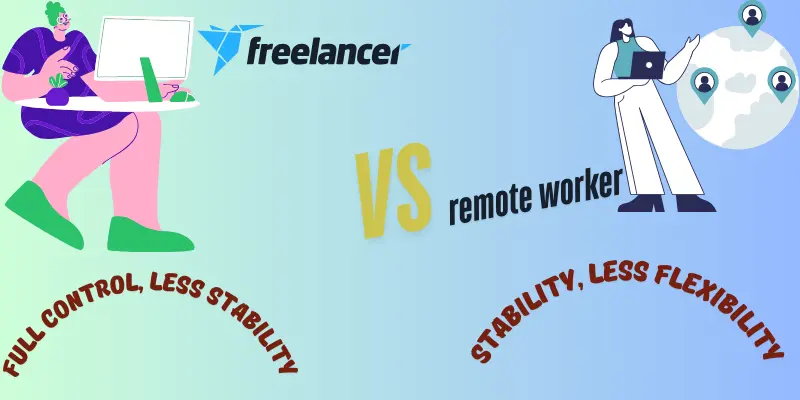Freelancing vs. Remote Jobs: Which Path Matches Your Skills?
Published: 21/05/2025
Did you know that approximately 35% of full-time employees worked remotely at least part-time in 2023? This shift reflects a significant change in how we approach work. Advancements in digital tools and technology have made it easier for individuals to work from virtually anywhere, leading to a rise in both freelancing and remote job opportunities. These flexible work arrangements offer the freedom to set your own schedule and achieve a better work-life balance.
But with these options comes a big question: Which path is the right fit for you? Should you embrace the independence of freelancing or the stability of a remote job? Let’s break down the key differences to help you make the best choice for your career and lifestyle.
What is Freelancing?
Freelancing refers to working independently, offering your skills and services to multiple clients without being tied to a single employer.
How it works:
Freelancers are self-employed individuals who manage their own business operations, such as finding clients, negotiating contracts, and handling their own taxes.
Common platforms:
- Upwork: One of the largest freelancing platforms for a wide range of jobs.
- Fiverr: A popular platform for small projects and creative work.
- Toptal: Known for high-end freelance opportunities in tech and finance.
- Freelancer.com: A platform connecting freelancers with businesses for various tasks.
What Are Remote Jobs?
Remote jobs are employment positions that allow you to work outside of a traditional office setting, typically from home, while still being employed by a company.
Types:
- Full-time: A regular, full-time position that offers a steady salary and benefits.
- Part-time: A job with fewer hours than a full-time position, often offering flexibility.
- Contract: Jobs with a specific duration, usually focused on a particular project or timeline.
Examples:
- Remote Developers: Software engineers who work for companies but remotely, writing code and building systems.
- Virtual Assistants: Professionals who provide administrative support remotely, handling tasks like scheduling, email management, and customer service.
- Customer Support Reps: Employees who manage customer inquiries and issues, often over phone or chat, but from a remote location.
Key Differences Between Freelancing and Remote Jobs
Freelancing and remote jobs may both offer flexibility, but they differ significantly in work structure, income stability, and benefits. Understanding these key differences can help you determine which path aligns best with your personal goals and work preferences.
| Feature | Freelancing | Remote Job |
| Work Type | Project-based | Ongoing employment |
| Income Stability | Variable (depends on projects/clients) | Predictable salary (steady paycheck) |
| Flexibility | High (set your own hours) | Moderate (typically fixed hours) |
| Benefits | None (unless self-funded) | Health insurance, PTO, retirement plans |
| Client/Employer Relationship | Multiple clients | Single employer |
| Skill Development | Broad but scattered (varied projects) | Focused growth (specialization in role) |
| Taxes | Self-managed (handle your own taxes) | Withheld by employer (standard payroll) |
| Tools & Platforms | Independent choice (you pick your tools) | Company-mandated tools (software provided) |
Key Takeaways:
- Freelancers enjoy high flexibility, choosing their projects and clients, but they face variable income and have to manage everything themselves (taxes, benefits, etc.).
- Remote workers have predictable salaries and access to company benefits like health insurance and retirement plans, but they usually have to follow a set work schedule and use tools provided by their employer.

Pros and Cons of Freelancing
Freelancing offers great independence and earning potential but comes with challenges like inconsistent income and no job benefits. Weighing these pros and cons can help you decide if it’s the right fit for your lifestyle and career goals.
| Pros of Freelancing |
|---|
Freelancing offers many appealing advantages for those who value independence and flexibility:
|
| Cons of Freelancing |
|---|
However, freelancing also comes with its challenges: No job security or benefits: Unlike traditional jobs, freelancers don’t have guaranteed income or employer-provided benefits like health insurance or retirement plans. Requires constant hustle: You’ll need to actively seek new clients, which can be tiring and time-consuming. Inconsistent income: Income can vary greatly from month to month, making budgeting more difficult. Managing taxes, contracts, invoicing: Freelancers must handle everything themselves, from filing taxes to creating contracts and managing payments. |
Pros and Cons of Remote Jobs
Remote jobs offer stability with a predictable income, benefits, and career growth, but they also come with fixed hours and less flexibility. Understanding these pros and cons can help you decide if this structured work environment suits your preferences.
| Pros of Remote Jobs |
|---|
Remote jobs come with several benefits that appeal to those seeking stability and structure: Stable income and benefits: Remote jobs offer a predictable salary and benefits like health insurance, paid time off, and retirement plans. Structured work environment: You’ll have clear expectations and guidelines, which can help with productivity and work-life balance. Career growth opportunities: Many remote roles offer chances for advancement within a company. Less isolation than freelancing: Remote workers often stay connected with a team, reducing feelings of loneliness that freelancers may experience. |
| Cons of Remote Jobs |
|---|
Despite the advantages, remote jobs also have certain downsides: Fixed hours and limited flexibility: Remote jobs typically require working within specific hours, reducing flexibility compared to freelancing. Fewer choices in projects/tasks: You’ll be assigned tasks by your employer, with less freedom to choose what you work on. May require specific time zone alignment: Some remote jobs require working in specific time zones, which can affect your schedule. Limited autonomy: You’ll have to follow your employer’s rules and processes, which may limit your independence. |
Finding Your Perfect Fit: Choosing Between Freelancing and Remote Jobs
To determine whether freelancing or a remote job is the right fit for you, ask yourself the following questions:
Do you enjoy managing your own schedule?
Freelancers often have the freedom to set their own hours, while remote workers typically work within a fixed schedule.
Are you comfortable selling your skills and finding new clients?
Freelancers need to market themselves and actively seek clients, whereas remote workers are hired by a company and don’t need to find clients.
Do you prefer working independently or as part of a team?
Freelancers work solo, taking full responsibility for projects, while remote workers are part of a team, collaborating with colleagues.
Is financial stability a top priority?
Remote jobs provide a stable income with benefits, while freelancing can offer higher earnings but with income variability.
Whether you’re leaning toward freelancing or a remote job, remember that, ‘The future of work is not about choosing between being a freelancer or an employee. It’s about finding the work style that aligns with your values and life goals.Tina Su, Freelance Consultant and Entrepreneur.
Mini Quiz or Checklist:
To help you assess which career path might suit you best, check the traits that resonate most with you:
- Freelancer-friendly traits:
- Enjoys flexibility and independence
- Comfortable with uncertainty and risk
- Good at time management and self-promotion
- Remote employee-friendly traits:
- Values stability and structured work
- Prefers being part of a team
- Seeks career growth and benefits like health insurance

When to Choose Freelancing
Freelancing is ideal for individuals who thrive in an independent, flexible environment. Consider freelancing if:
- Creative professionals (writers, designers, video editors): If you have a creative skill that you can offer to clients, freelancing gives you the freedom to choose projects that match your expertise.
- Those who enjoy variety in work: Freelancers often work on different projects, giving them a diverse range of experiences and the opportunity to build a varied portfolio.
- People confident in sales, negotiation, and self-promotion: Freelancers need to market their skills, negotiate rates, and attract clients. Confidence in these areas is key to success.
- Individuals seeking full independence: Freelancing allows you to set your own hours, choose who you work with, and decide the type of projects you take on, offering full control over your work life.
When to Choose Remote Work
Remote work is a great option for those seeking stability and long-term career growth. Consider remote work if:
- Professionals looking for stability and growth: Remote jobs offer a steady income, company benefits, and opportunities for advancement within a structured organization.
- Those who thrive in structured environments: If you prefer having a clear schedule, defined tasks, and support from a team, remote work provides a more predictable work setup.
- Employees seeking benefits and career progression: Remote roles often come with benefits like health insurance, paid time off, and retirement plans, along with opportunities for professional development.
- People who want less administrative burden: Unlike freelancers, remote workers don’t have to worry about handling contracts, invoicing, or finding clients—those are all managed by the employer.
Balancing Both Worlds: Is It Possible to Freelance and Work Remotely?
It’s possible to combine remote work with freelancing, allowing you to enjoy the stability of a full-time job while exploring the flexibility of freelancing. Here’s how you can balance both:
- Remote work full-time, freelancing on the side: Many people choose to work a remote job during the day and take on freelance projects in their spare time. This can help provide a stable income while still offering the freedom to pursue side projects.
- Tips for balancing both without burnout:
- Set clear boundaries: Define your working hours for both your remote job and freelance work to avoid overlap.
- Prioritize tasks: Use a calendar or task manager to keep track of deadlines and responsibilities.
- Take regular breaks: Avoid overloading yourself by scheduling rest periods to recharge.
- Real-life example: Jane, a graphic designer, works as a remote marketing coordinator full-time and takes on freelance design projects in the evenings. She has found a good balance by keeping her work hours separate and using weekends to focus on her freelance clients.
Making the Switch: Steps to Start Freelancing or a Remote Job
Whether you’re stepping into freelancing or a remote job, taking clear, actionable steps is key. Start by building a portfolio or updating your LinkedIn profile to make a smooth transition into your chosen career path.
Steps to start freelancing:
If you’re looking to start freelancing, follow these steps to get started:
- Build a portfolio: Showcase your best work in a professional portfolio to attract potential clients.
- Create profiles on freelance platforms: Sign up on platforms like Upwork, Fiverr, or Toptal to start finding freelance gigs.
- Set rates and pitch to clients: Determine your pricing and begin pitching your services to clients that align with your skillset.
Steps to land a remote job:
If remote work is more appealing, here’s how to start:
- Update LinkedIn profile: Highlight relevant remote work experience and skills to make your profile attractive to remote employers.
- Apply to remote-specific job boards: Explore job boards like We Work Remotely or FlexJobs that specialize in remote job listings.
- Prepare for remote interviews: Be ready to demonstrate your ability to work independently, communicate virtually, and handle remote job responsibilities during the interview.
Essential Tools and Resources for Freelancers and Remote Workers
Freelancers and remote workers rely on specific tools to stay organized, communicate, and manage tasks efficiently. Whether it’s time tracking for freelancers or communication tools for remote teams, these resources help streamline work processes.
Freelancers:
To stay organized and efficient, freelancers rely on a variety of tools for managing their work:
- Time tracking:
- Toggl: Simple time tracking to keep tabs on billable hours.
- Harvest: Offers time tracking and invoicing in one tool.
- Invoicing:
- FreshBooks: Invoicing software designed for small businesses and freelancers.
- Wave: A free tool for invoicing and accounting.
- Contracts:
- LegalZoom: For creating legal contracts and documents.
- Bonsai: A platform that helps freelancers with contracts, proposals, and payments.
Remote Workers:
Remote workers use these tools to communicate, collaborate, and stay productive:
- Communication:
- Slack: A messaging platform for team communication.
- Zoom: A popular video conferencing tool for meetings and collaboration.
- Task Management:
- Asana: A project management tool to organize tasks and deadlines.
- Trello: A simple, visual way to manage projects and track progress.
- Productivity:
- Notion: An all-in-one workspace for notes, tasks, and collaboration.
- Google Workspace: A suite of tools like Gmail, Docs, and Sheets to improve productivity and collaboration.
Real Stories: How Freelancers and Remote Workers Succeed
Real-life stories from successful freelancers and remote workers can provide valuable insights and inspire others. Here are some examples:
- A Successful Freelancer – Neil Patel:
- Journey: Neil Patel is a renowned digital marketing expert who started his career as a freelancer. He initially offered SEO services before building his own digital marketing empire.
- Challenges: Neil struggled to find clients in the beginning and had to prove his value in a competitive field.
- Advice: “Focus on building a brand, not just a business. Content is key—always provide value first, and success will follow.”
- A Happy Remote Employee – Basecamp’s Jason Fried:
- Journey: Jason Fried, co-founder of Basecamp, has been a remote employee and remote work advocate for years. His company operates remotely, allowing employees to work from anywhere.
- Challenges: Early on, Jason faced the challenge of transitioning to remote work and ensuring effective communication among his team members.
- Advice: “Trust your team, prioritize communication, and create a structure that works for everyone—remote work isn’t about being physically present, it’s about being present in the work you do.”
Final Thoughts: How to Choose the Best Path for Your Career
In the end, choosing between freelancing and remote work comes down to what matters most to you. Freelancing offers flexibility, independence, and the potential for higher earnings, but comes with the challenges of inconsistent income and no job benefits. Remote jobs, on the other hand, provide stability, a predictable salary, and benefits, but with less flexibility and autonomy.
Remember, there’s no “one size fits all” when it comes to these career paths. Take time to reflect on your personal goals, work preferences, and skills. Do you value independence or stability more? Are you comfortable managing your own schedule, or do you thrive in a structured environment?
Ultimately, the right choice depends on what aligns best with your lifestyle and long-term goals. Let us know in the comments which path you’re considering or if you need more advice! And if you’re still undecided, check out our related posts for more tips on navigating these career options.
We’d love to hear from you! Take the next step by engaging with us:
Comment below: Share your experience—are you leaning toward freelancing or remote work? What challenges or successes have you faced in your career journey?
“The freedom to choose your path is the first step to true success—whether it’s through freelancing or a remote job, it’s about finding balance and what works best for you.”
Common Questions Answered: Freelancing vs. Remote Work
Freelancers often experience income fluctuations depending on the number of clients and projects they have. Unlike remote jobs, which offer a predictable salary, freelancing income can vary from month to month.
Start by building a portfolio showcasing your best work. Sign up for freelance platforms like Upwork or Fiverr, and start pitching your services to potential clients. Also, setting competitive rates and promoting your skills are key to getting started.
Yes! Many people start with a remote job for stability and gradually transition to freelancing. You can begin by freelancing part-time in your spare hours, then shift to full-time freelancing once you’re ready.
Remote jobs typically offer more opportunities for career progression within a company, along with benefits like paid time off and retirement plans. Freelancers have more freedom but may face challenges in terms of long-term stability and growth within a specific field.
It can be. Freelancers often work alone, which might lead to feelings of isolation. To combat this, some freelancers schedule coworking days or join online communities to stay connected.
No, remote jobs are available in various fields, including marketing, customer service, writing, and education. The key is finding companies that offer remote positions in your area of expertise.
Not necessarily. Many freelancers succeed by building a strong portfolio and gaining experience. For example, a graphic designer might start by creating designs for friends or volunteering, gradually building a client base.
It depends on your employer’s policies and the legal requirements of the country you wish to work from. Some companies allow remote work from abroad, while others have restrictions due to tax or legal reasons.

- Be Respectful
- Stay Relevant
- Stay Positive
- True Feedback
- Encourage Discussion
- Avoid Spamming
- No Fake News
- Don't Copy-Paste
- No Personal Attacks



- Be Respectful
- Stay Relevant
- Stay Positive
- True Feedback
- Encourage Discussion
- Avoid Spamming
- No Fake News
- Don't Copy-Paste
- No Personal Attacks





